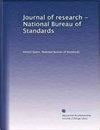Imaging Microanalysis of Materials with a Finely Focused Heavy Ion Probe
Journal of research of the National Bureau of Standards
Pub Date : 1988-05-01
DOI:10.6028/jres.093.084
引用次数: 1
Abstract
Liquid metal ion sources (LMIS) in view of the quasi-point-like geometry of their emitting region and confined emission cone possess brightness (0I6 A cm 'sr-') which is adequate for the realization of high current density (I A cm-'), finely focused (>20 rm) probes. A 40 keV scanning ion microprobe, which makes use of a Ga LMIS (UCHRL SIM) is currently employed in our laboratory to obtain chemical maps of materials in a variety of interdisciplinary applications [1]. The instrument is composed of a two-lens focusing column, a hightransmission secondary ion energy analyzer and transport system, and an RF quadrupole mass filter for secondary ion mass spectrometry (SIMS). in addition, two-channel electron multiplier detectors, overlooking the target region, collect secondary electrons or ions for imaging of the surface topography and material contrast of a sample. Although a lateral resolution of 20 nm has been attained, sensitivity considerations favor operation at somewhat larger (50-70 nmt) probe size. The analytical image resolution is in fact critically dependent on the statistics of the mass analyzed signal [2], which in turn is determined by the rate of material removal by sputtering from the sample surface. Such a rate is proportional to the probe current, which decreases with the square of the probe diameter for chromatic-aberration-limited probes such as those extracted from LMIS. Thus at, e.g., 20 nm probe diameter, only 1-2 pA of probe current are available, the erosion rate is of the order 10-' rnonolayers/s and probe-size resolution can only be attained for elements of high ionization probability which will provide the highest signal statistics over an acceptable recording time (>I count/pixel in a 1024 x 1024 pixel scan for a 512 s acquisition time for the UC-HRL SIM). In view of the well known range of ionization probabilities (ion fractions) among sputtered atomic species, as well as of sputtering yields, the attainable analytical lateral resolution of finely focused probes becomes target-species dependent due to the above considerations. It also follows that for species difficult to ionize, high resolution SIMS imaging microanalysis is altogether precluded, unless by recourse to postionization techniques [3]. Two examples of applications of the UC-HRL SIM to the study of materials will be illustrated in the present context.精细聚焦重离子探针对材料的成像微分析
液态金属离子源(LMIS)由于其发射区域和受限发射锥的准点状几何结构,其亮度(0I6 A cm 'sr-')足以实现高电流密度(1 A cm-')、精细聚焦(>20 rm)的探针。一个40 keV扫描离子微探针,它利用了一个Ga LMIS (UCHRL SIM),目前在我们的实验室使用,以获得各种跨学科应用中材料的化学图谱。该仪器由双透镜聚焦柱、高透射二次离子能量分析仪和输运系统、用于二次离子质谱(SIMS)的射频四极质过滤器组成。此外,双通道电子倍增探测器,俯瞰目标区域,收集二次电子或离子成像的表面形貌和材料对比的样品。虽然已经达到了20纳米的横向分辨率,但灵敏度方面的考虑倾向于在稍大(50-70纳米)的探针尺寸下操作。分析图像的分辨率实际上严重依赖于被分析信号[2]的统计量,而[2]又由样品表面溅射的材料去除率决定。这种速率与探针电流成正比,对于那些从LMIS中提取的有色差限制的探针,探针电流随探针直径的平方而减小。因此,例如,在20 nm的探针直径下,只有1-2 pA的探针电流可用,腐蚀速率为10- 1纳米层/秒,探针尺寸分辨率只能达到高电离概率的元素,这将在可接受的记录时间内提供最高的信号统计(在1024 x 1024像素扫描中,>I计数/像素,UC-HRL SIM的采集时间为512秒)。鉴于溅射原子种类之间的电离概率(离子分数)以及溅射产率的已知范围,由于上述考虑,精细聚焦探针可获得的分析横向分辨率变得依赖于靶种。这也意味着,对于难以电离的物种,高分辨率的SIMS成像微分析是完全排除的,除非通过求助于定位技术bbb。本文将举例说明UC-HRL SIM在材料研究中的两个应用实例。
本文章由计算机程序翻译,如有差异,请以英文原文为准。
求助全文
约1分钟内获得全文
求助全文

 求助内容:
求助内容: 应助结果提醒方式:
应助结果提醒方式:


